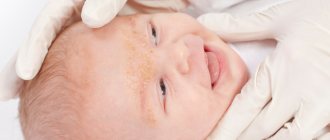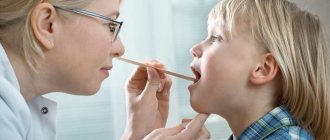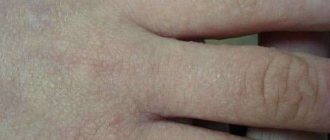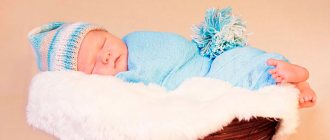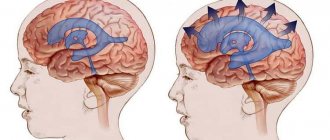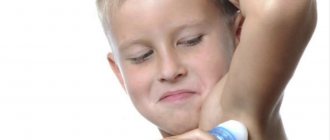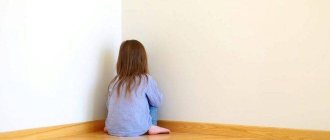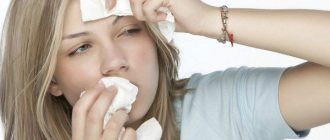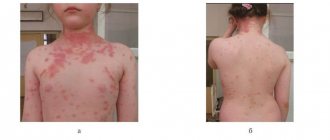Causes of crusts
After birth, the child adapts to the sudden change in the environment for several months. All functions of a fragile body are aimed at adapting to new conditions - including the work of the sebaceous glands. Due to their hyperactivity, flaking of the scalp sometimes occurs. This phenomenon is physiological and does not cause discomfort. Over time, the secretion of skin secretions returns to normal, and the problem disappears without a trace.
Sometimes, in addition to the natural causes of the appearance of scales in a baby, there are other culprits of peeling:
- Allergy. The skin of a newborn can react in this way to an unfamiliar product eaten by the mother, of course, under the condition of breastfeeding. In children on artificial nutrition, switching to another formula often provokes allergies.
- Overheat. Continuous wearing of a cap or cap can cause increased sweating in the baby. Constant humidity and high temperature are factors leading to the appearance of seborrheic crusts.
- Excessive hygiene. Washing your hair too often disrupts the protective functions of the skin, contributing to dryness and tightness of the epidermis. The body's response will be the active work of the sebaceous glands and the subsequent appearance of scales.
- Reaction to cosmetics. A baby's skin is sensitive and prone to irritation. Incorrect care can harm her. For gentle cleansing, it is necessary to select hypoallergenic products created specifically for newborns.
Important! Before trying to remove scales on a child’s head, you should exclude the influence of external factors that provoke the formation of seborrheic dermatitis.
Dry crusts on the skin are, first of all, an aesthetic problem that does not cause any inconvenience to the baby. Without outside intervention, they will gradually go away in 6-12 months. However, many mothers are interested in the question of how to remove scales that spoil the appearance of their beloved child. There are safe ways, which will be discussed below.
Crusts on the head of a 5-year-old child: causes and treatment methods
0
0
The scalp of young children has an extremely delicate structure. Local tissues instantly react to the influence of all kinds of irritants. The baby's body is not able to adequately perceive excessive stimulation of the sweat and sebaceous glands. The result is often the formation of scaly structures on the head, which are a mixture of damaged epidermis and sebum.
What factors provoke the formation of a crust on the head of a 5-year-old child? How dangerous is the disease? What is the treatment for seborrheic dermatitis of the scalp? We invite you to find out the answers to these questions from our publication.
Body overheating
What causes crusts on the scalp in children? Why does this trouble arise? A common cause is dry, warm indoor air and infrequent ventilation of the home.
Some parents are too concerned about their baby not catching a cold. As a result, the child is constantly wearing a bunch of things. The scalp begins to produce a large amount of sweat.
The latter connects with fatty secretions.
A combination of factors increases the risk of seborrheic crusts. The picture gets worse if the child has to wear a hat all day long. It is quite natural that with the onset of cold weather, parents should definitely put a hat on their baby. However, when you are in a warm room, this seems completely irrational.
Using the wrong shampoo
Another reason for crusts on a child’s head is the use of cosmetics that contain aggressive synthetic components. It is important for parents to carefully study the composition of baby shampoo before purchasing.
It should not contain surfactants. Such substances have too active an effect on the delicate epidermis. All kinds of aromatic substances and dyes dry out the skin.
As a result, not only seborrheic crusts may appear on the child’s head, but there may also be signs of allergic reactions.
Responsible parents should use only safe, environmentally friendly, pediatrician-approved shampoos. Bathing products should be hypoallergenic. In a situation where expensive products are not available due to a limited family budget, use the most ordinary baby soap, which does not have a rich aroma and has a neutral shade.
Wrong approach to washing your hair
Young children's hair gets dirty quite quickly. The reason is mobility and activity. Considering the above, regularly washing a child's hair seems like the right decision on the part of parents. However, you need to follow a number of rules so as not to harm the baby.
Quite often, a child develops a crust on his head if he frequently uses a hard washcloth. The delicate epidermis is quickly injured. Small particles of surface tissue begin to peel off. On top of everything else, there is the active production of sebaceous secretions, which are released under the influence of stimulation of local glands.
If crusts form on the head of a child 5 years old or younger, mom and dad should try to wash the baby’s hair very carefully. Under no circumstances should you scrape off particles of dirt with your fingers, sponge or washcloth.
By carelessly picking at dry epidermis while washing hair, parents create discomfort for their own child and provoke the development of infections. Among other things, you should not pull out your baby's tangled hair while combing.
It is better to trim the strands carefully.
Immune disorders
Crusts on the head of a 5-year-old child can form in the event of a malfunction of the immune system. If the body's defenses are in perfect order, pathogenic yeast fungi do not attack the scalp.
Impaired immunity often entails the active proliferation of pathogenic microorganisms in the structure of the delicate epidermis. To avoid trouble, parents need to treat their child’s colds in a timely manner.
It is important that a child’s body gets enough vitamins.
Poor nutrition
It is important for children prone to developing seborrheic dermatitis of the scalp to eat properly.
In order for the crusts on the head of a 5-year-old child to quickly disappear, parents should introduce low-calorie foods into their child’s daily diet.
The basis should be all kinds of cereals, lean soups, boiled lean meat, vegetable salads, fresh fruits, and natural juices. Don't forget about dairy products.
It is imperative to exclude carbonated drinks and all kinds of sweets from your diet.
If there are hints of seborrheic dermatitis of the scalp, doctors advise parents to offer their children less fried foods, smoked foods, and dishes richly seasoned with spices.
The development of dermatitis can be triggered by a child eating an abundance of flour products, in particular, buns and white bread.
Allergic reactions
Seborrheic dermatitis of the scalp in children is often a consequence of the development of allergies. Parents should find out what stimulus the baby’s body reacts incorrectly to.
It makes sense to visit a doctor to determine the problematic allergen through special tests.
It is probably worthwhile to temporarily limit the child’s contact with pets, combat the spread of dust throughout the apartment by frequent wet cleaning, and close windows during the period of active flowering of plants.
Diagnostics
Before you begin self-treatment of seborrheic dermatitis of the scalp in a child, you should make an appointment with a doctor. A dermatologist and trichologist can confirm a disappointing diagnosis. Additionally, consultation with a neurologist, gastroenterologist, or endocrinologist may be required.
Subject matter specialists will give a correct assessment of the phenomenon during a visual inspection. Doctors will perform an analysis by doing a skin test on the problem area of the scalp. The method will identify spores of the pathogenic fungus. Only after a high-quality diagnosis is it advisable to proceed directly to therapy.
Medicinal shampoos
If a crust forms on the head of a 5-year-old child, what should you do? The first step should be the use of special shampoos.
The most effective options include products containing selenium sulfide, salicylic acid, ketoconazole, and zinc.
Parents who prefer exclusively natural products should use shampoos based on birch tar.
Apply treatments to your child's scalp daily. As the characteristic symptoms disappear, the use of special shampoos should be reduced to use 2-3 times a week. To prevent the pathogen from adapting to the action of the same substances, change shampoos periodically.
Immunomodulators
In order to treat crusts on children's heads, doctors prescribe the use of so-called immunomodulators. The drugs Protopic and Elidel are considered effective remedies for seborrheic dermatitis.
These compositions quickly soothe the inflamed epidermis and are distinguished by pronounced antifungal properties. However, long-term use of such medications should be avoided to avoid skin atrophy.
Before starting treatment of seborrheic dermatitis in a child with this method, it is important to obtain the approval of a doctor.
Treating leather with oils
Proven remedies for crusts on a child’s head are sunflower, almond and olive oil. It is also safe to use Vaseline. After gently treating the scalp with one of these substances, dress the baby’s head in a cap made of breathable, natural material. This will allow the product to work more effectively. After several hours, rinse off the composition with warm water.
Removing scales with a comb
To combat the formation of characteristic scales, periodically use a comb that has rounded teeth. Remove crusts that come off easily. Try not to further injure the delicate epidermis.
Remove flakes stuck in hair. Perform this procedure daily. Make sure your child touches his head as little as possible.
Regularly scratching irritated skin with dirty hands is fraught with the development of infections in the structure of local tissues.
Burdock infusion
A fairly effective folk remedy in the fight against seborrheic dermatitis is burdock infusion. The medicine is prepared according to the following scheme:
- Take several shoots of burdock.
- The raw materials are passed through a meat grinder or crushed in a blender.
- The pulp is placed in a piece of gauze and the juice is squeezed out.
- About 2 teaspoons of the substance are combined with a few drops of burdock oil.
- Add half a dessert spoon of liquid honey to the composition.
- The resulting mass is mixed until a homogeneous consistency.
- The product is left to infuse for 24 hours.
The medicine is applied to damaged scalp. Place a layer of cling film on top. The baby's head is covered with a cap. After an hour, the product is thoroughly washed off with warm water. The hair is allowed to dry without using a hair dryer. Therapy is performed several times a week. The method allows you to eliminate severe symptoms of seborrheic dermatitis within a month.
Nettle decoction
To make a healing remedy for removing crusts on the scalp, prepare about 100 g of fresh nettle leaves. Pour the raw materials with boiled water in a volume of 500 ml.
Add a few tablespoons of non-concentrated table vinegar. Place the mixture in an enamel pan and keep it on low heat for half an hour. Let the broth cool to room temperature.
Soak gauze with the product and place it on the child’s head. Use lotions several times a week.
St. John's wort ointment
A good remedy for treating seborrheic dermatitis is an ointment made from the herb St. John's wort. The medicine is prepared as follows. Take fresh shoots of a medicinal plant. St. John's wort is thoroughly crushed. The resulting mass is placed in gauze and the juice is squeezed out.
The liquid is placed on low heat and thoroughly evaporated until a substance with a viscous consistency is formed. The base of the medicine is combined with butter in a ratio of 1:4. The composition is thoroughly mixed and then placed in the refrigerator for a day.
Areas of the scalp affected by seborrhea are lubricated with the medicine 2-3 times a week.
Finally
As you can see, crusts on a child’s head can occur due to a number of reasons. Having noticed the characteristic yellowish scales, parents should regularly remove the flaky particles using a gentle method.
If you take actions aimed at maintaining a favorable microclimate in the room, normalizing hormonal levels in the child’s body, strengthening the immune system, unpleasant symptoms will disappear on their own.
Source: .ru
Source: https://newrussianmarkets.com/dom/korochki-na-golove-y-rebenka-5-let-prichiny-i-metody-lecheniia.html
How to get rid of seborrheic scales
When helping a baby cope with peeling, the main thing is not to cause him pain. To safely eliminate the problem, you can use home and medical remedies, depending on your skin condition.
The procedure for removing crusts step by step looks like this:
We recommend reading: Dry skin in a newborn
- Softening. To moisturize the growths, apply vegetable oil or Vaseline to the scalp of the baby. It is better to choose a sterile product for these purposes. Using cotton wool, the product is carefully distributed over the desired area, after which it is left for 30 minutes to act. For greater effectiveness, you should put a clean knitted cap on your baby.
- Massaging. After softening, you need to carefully comb the affected areas with a comb with natural bristles. Do not press with force - the crusts should easily come away from the surface of the skin. You may need to rinse the brush several times during the combing process.
- Bathing. Wash off any remaining oil and crusts with warm water and baby shampoo. It is important to ensure that contaminated water does not get into the eyes - this will cause discomfort to the baby. It is unlikely that you will be able to completely get rid of the growths in one session, so there is no need to repeatedly lather or scrub your scalp.
- Drying. Complete the process as you would a normal bath, gently blotting away the moisture with a towel.
It will likely take several sessions to completely get rid of seborrheic dermatitis.
It is important to remember that combing out the scales should not be repeated every day - this will lead to overdrying of the skin, causing the opposite result. The optimal frequency would be to carry out the procedure no more than once a week.
It is unacceptable to tear off dry growths with nails or a comb - this is fraught with trauma to the skin and subsequent infection.
You can buy a softening agent to eliminate seborrheic crusts at the pharmacy along with instructions for use. Experts advise using such means as a last resort, since they can cause an individual reaction in the baby. It would be better to consult a pediatric dermatologist before using them.
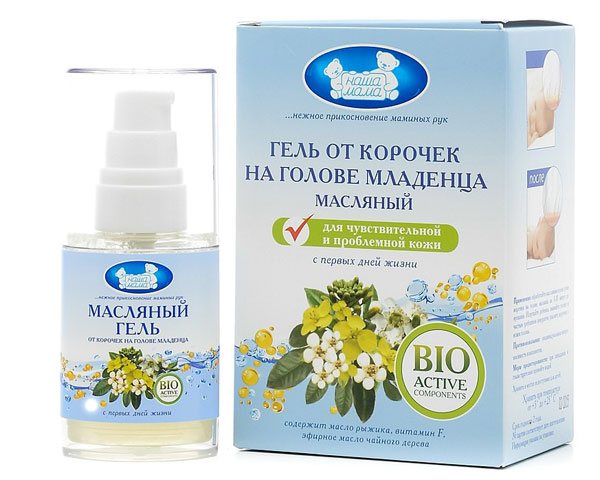
An alternative to the traditional method is the use of a softening medicinal product.
Yellow spots on the head
Yellow crusts on a baby's head are seborrheic dermatitis, which appears due to excessive secretion of sebum. Crusts do not indicate any disease, but they cannot be ignored.
Sometimes they can appear on the eyebrows and other parts of the baby's body. It happens that they appear in the first days after birth or closer to a year. Seborrheic dermatitis does not require drug treatment, and it usually disappears on its own. Many mothers know what seborrheic dermatitis looks like on the baby's head, because it occurs quite often. It can be:. Yellow crusts on the head of a newborn most actively appear between the ages of 10 days and 3 months.
How long will they last? This depends on the individual characteristics of the baby’s body. Most often, crusts on a child’s head disappear without a trace before the age of one year, and sometimes they persist for up to years.
Being under the hair, they do not cause any difficulties when combing the baby. Experts have not established the exact causes that lead to the appearance of seborrheic dermatitis. There are only the following assumptions:. Only a specialist can make an accurate diagnosis. A dermatologist, by comparing all the signs, is able to distinguish the pathology from ringworm, psoriasis, and an infectious skin disease.
The diagnosis is made by external examination and based on test results. The origin of yellow crusts on a baby’s head is determined using a skin biopsy, mycological examination of scales and a study of the baby’s hormonal status.
Yellow crusts on a baby's head do not pose a threat to the baby's life. Treatment of seborrhea does not require the use of serious medications; it can disappear from the skin on its own over time. To quickly get rid of unpleasant seborrhea, in many cases pediatricians recommend taking the following measures:
Any of the listed remedies should be used only after it has been prescribed by a specialist, but not more than 2 times a day. In addition to medications, you can get rid of yellow crusts on a baby’s head using traditional medicine. There are gentle and proven methods. How to remove yellow crusts from a baby's head? The main method of treatment includes the use of various oils: sea buckthorn, sunflower or olive.
They are able to soften the scales, which will allow mom to easily remove them. The treatment process is as follows: The same method will help remove crusts on the eyebrows and behind the ears. Parents should monitor the effect of the cream or shampoo.
If an allergic reaction occurs, use of this product should be discontinued. If parents find yellow crusts on the child’s head, then it is prohibited to rip them off from dry skin. This will lead to the appearance of new scales. Also, this method of getting rid of crusts can lead to wounds on the head. This leads to infection and worsening of the condition. Complications can appear under the influence of the following negative factors: improper care, unbalanced nutrition or dry skin.
Only in such cases do yellow crusts on a baby’s head represent a depressing condition. Negative consequences include:. If such symptoms occur, the baby must be urgently shown to a specialist. Indeed, in such a situation, more serious treatment will be needed.
If the problem is successfully resolved, mothers look for solutions that can prevent its recurrence in the future.
Dr. Komarovsky suggests that women during lactation eat properly, reducing the amount of fats and carbohydrates in the diet. After all, this directly affects the fat content of milk. If the baby has yellow crusts on his head, the mother should not be upset. They are completely harmless and can be treated with simple remedies. Wearing masks and gloves: in Ukraine, priests returned to their duties. A mother left her children in the bathroom for 15 minutes, but then greatly regretted it. A past that will never return.
The architect tried to make the entrance to the 2nd floor for my mother not via the stairs (photo). People have difficulty with this quiz: questions about animals, countries and seas. Independent, uncomplicated: what attracts young men to women? Were there beautiful shoes in the USSR? What did our mothers and grandmothers wear? photo.
A painful connection and the last meeting. Alferova spoke about her marriage to Abdulov. From a retractable awning to an expensive gazebo, 10 ways to create shade in your backyard. A rare beauty: what the actress from “Broken Mirror” was like in her youth. The son advised the summer father to find a new wife.
The answer made him think. It's time to feed the cabbage. I make a green compote and add chalk. The twins were laughed at because they were overweight.
If only these people could see how they grew up. Thanks to the spicy marinade, the meat becomes very tender: prepare pork tenderloin. Home Home and family Children. Main signs Many mothers know what seborrheic dermatitis looks like on the baby’s head, because it occurs quite often. These may be: Yellowish crusts that cover partially or completely the scalp of the baby's head.
Their greatest concentration may be in the parietal part. The scales accumulate in a dense layer. Crusts can also form on other parts of the body. In rare cases, they are found on the neck, face and behind the ears. Yellow crusts on the head are not accompanied by inflammation and do not cause irritation. This is how they differ from atopic dermatitis. The crusts look unattractive, but do not cause itching. They do not cause negative feelings to the child.
Victoria Fedorova August 10, Comments 0. New Discussed Popular. I want to receive. New comments to your personal account. Replies to my comments. Read online - Follow new comments - 7. Cancel Reply. Editing a comment is possible within five minutes after it is created, or until a response to this comment appears. Cancel Save. Unsolicited advertising or spam.
Materials of a sexual or pornographic nature. Child pornography. Drug propaganda. Violence, self-harm. Account hacking.
Fake account.
Prevention of scales
If not properly cared for, the crust may reappear even after it has been completely eliminated. Following simple measures will prevent the re-formation of growths:
- Maintaining a healthy indoor microclimate. Regular ventilation and the use of a humidifier are the key to the well-being of any person, especially a newborn. Moist, cool air prevents the baby's skin and mucous membranes from drying out, strengthening local immunity.
- Hardening. Taking air baths has a beneficial effect on the functioning of the entire body.
- Avoiding overheating. You should not dress your baby in a hat or bonnet 24/7—the skin must breathe. In a warm room, the child will be more comfortable without a hat.
- Use of children's cosmetics. You need to take the purchase of shampoo for babies seriously. You should not purchase a product from an unknown brand. Leading manufacturers of baby care lines monitor product safety, offering a wide range of hypoallergenic cosmetics. Such cleansing products will reduce the occurrence of negative reactions to a minimum.
Finding scales on your baby's head is not a reason to panic. To eliminate and prevent them, it is enough to monitor the baby’s hygiene, comfort and nutrition, and soon the problem will disappear forever.
Preventive measures
To prevent the initial appearance or to maintain the result after treatment, prophylaxis is necessary. Easy to follow but effective tips:
- In a warm room, you should not wear a lot of clothes; it is better to take off your hat.
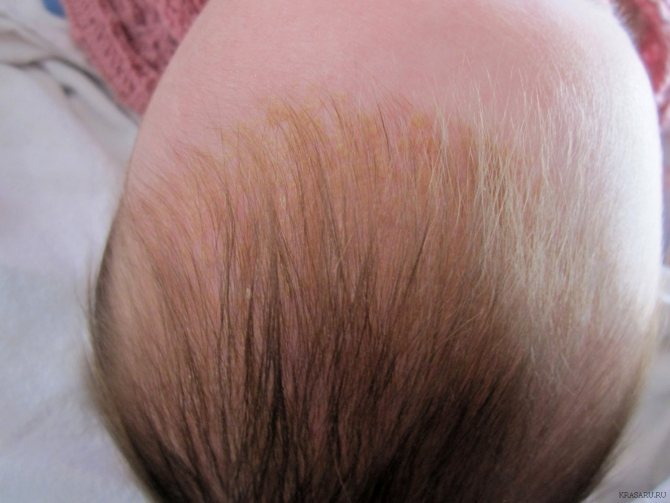
It is necessary to create an optimal level of humidity in the room.- When bathing, you must use special fragrance-free baby products.
- Use detergents 1-2 times a week, and the rest of the time it is enough to rinse the baby with warm water;
- Baby cream marked 0+, applied to damp skin after bathing, retains moisture.
- According to Komarovsky, crusts on a baby’s head are in many cases associated with the diet of mother and child. Lep accompanied by allergic symptoms may be caused by components of an inappropriate mixture. In this case, it is necessary to change your diet after consultation with your pediatrician.
Doctors still have not come to a consensus on whether it is worth getting rid of birth dirt. If the baby is cheerful and cheerful and does not pay attention to the crusts, then parents have nothing to worry about.
